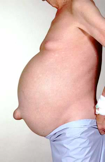Portal Venous Anatomy

The liver is vital organ in the human body. It performs hundreds of functions including protein synthesis, detoxification, drug metabolism, and synthesis of molecules necessary for the digestive system.
Blood supply (Top):
The liver receives the venous blood from the stomach, pancreas, and large intestine via the portal vein. This venous blood passes through the liver where the liver tissue metabolizes drugs present in the blood, absorbs nutrients, and detoxifies toxins. After passing through the liver the venous blood is drained from the liver via the hepatic veins. The hepatic veins drain directly into the inferior vena cava which feeds into the right atrium of the heart. From there the heart circulates the venous blood to the lungs to become oxygenated before it is sent back to the peripheral tissues.
Portal Hypertension:
Portal hypertension is an increase in the pressure of the portal vein. Causes vary from cirrhosis to portal vein thrombosis (clotting) but the underlying reason for increase in pressure in the portal vein is an increase in resistance to blood flow through the liver. This increased resistance to blood flow results in increasing pressures in the portal vein. Portal hypertension can be a life threatening condition because it can lead to esophageal and anal varices that have a propensity to rupturing that can cause rapid blood loss that can be deadly.
Varices (Bottom Right):
Esophageal and anal varices are caused by increased pressure in the portal venous system. Portal hypertension results from increased resistance to blood flow through the liver. As a result of this increased resistance, the venous blood draining from the large intestine, stomach, and pancreas attempts to find alternate routes to return back to the right side of the heart. Two routes to bypass the liver on the way back to the right atrium are in the small veins of the esophagus and the anal canal. These narrow veins were not designed to handle the flow and pressures that they are exposed to under portal hypertension. As a result these veins become distended and are at risk of rupture. Rupture of these varices can be rapidly deadly.
Ascites (Bottom Left):
Ascites is an increase in fluid collection in the abdomen. It is caused by the increased hydrostatic pressure in veins draining into the liver via the portal vein. The increased hydrostatic pressure results in movement of fluids from the venous compartment into the interstitial tissues. The result can be as severe as the severely distended abdomen seen on the bottom left. It can be disfiguring and very difficult to treat.

